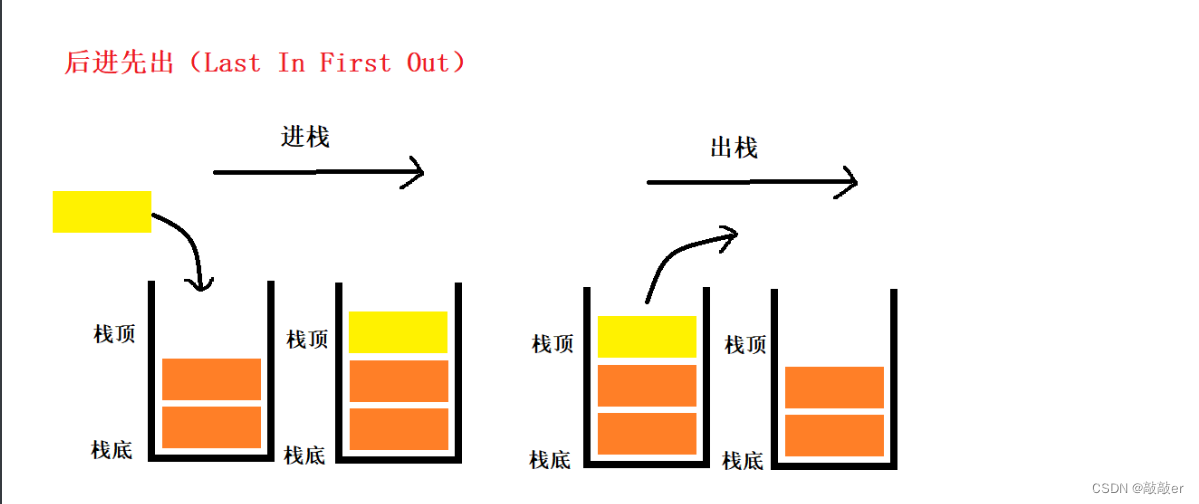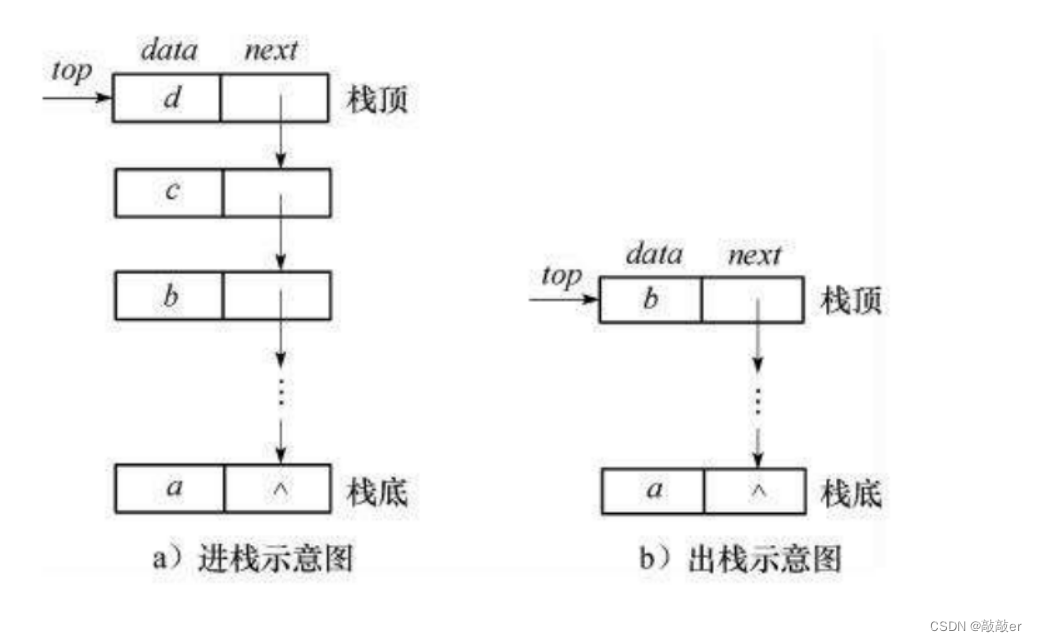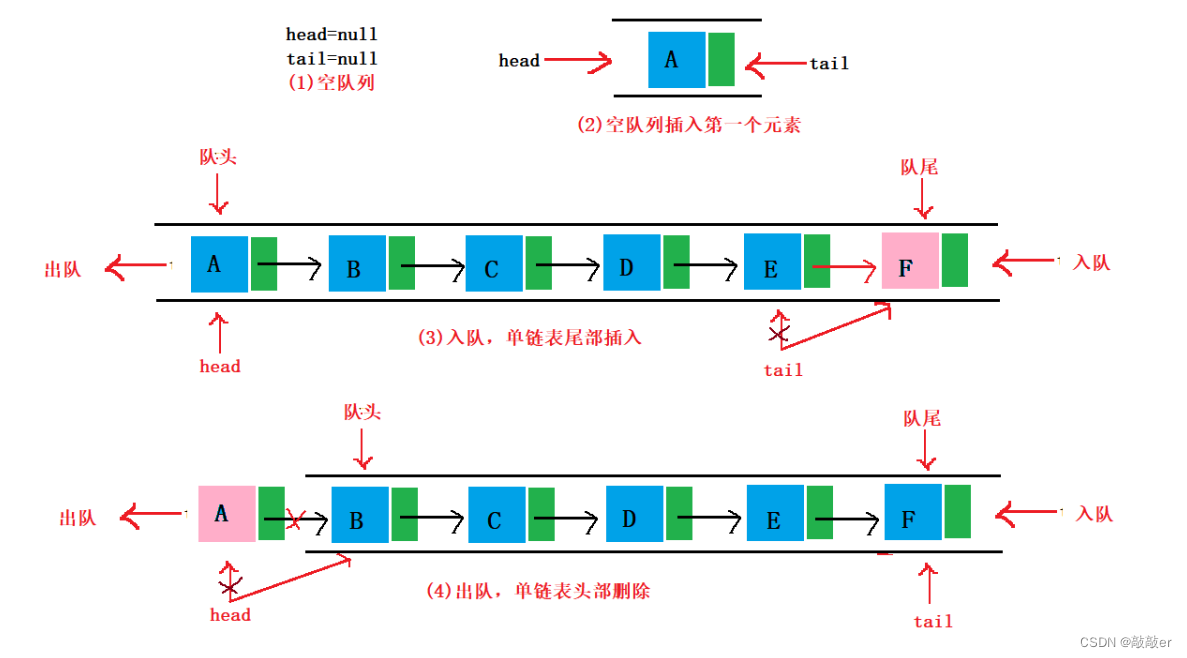1.栈
1.1栈的概念及结构
栈:一种特殊的线性表,其只允许在固定的一端进行插入和删除元素操作。 进行数据插入和删除操作的一端
称为栈顶,另一端称为栈底。 栈中的数据元素遵守后进先出LIFO(Last In First Out)的原则。压栈:栈的插入操作叫做进栈/压栈/入栈,入数据在栈顶。
出栈:栈的删除操作叫做出栈。出数据也在栈顶。

1.2栈的实现
栈的实现一般可以使用数组或者链表实现,相对而言数组的结构实现更优一些。因为数组在尾上插入数据的
代价比较小。


代码
Stack.h
#define _CRT_SECURE_NO_WARNINGS 1
#pragma once
#include
#include
#include
#include
#include
// 下面是定长的静态栈的结构,实际中一般不实用,所以我们主要实现下面的支持动态增长的栈
//静态栈
typedef int STDataType;
#define N 10
typedef struct Stack
{
STDataType _a[N];
int _top; // 栈顶
}Stack;
//动态栈 支持动态增长的栈
typedef int STDataType;
typedef struct Stack
{
STDataType* a;
int top;//栈顶
int capacity;//容量
}ST;
//初始化栈
void STInit(ST* ps);
//销毁栈
void STDestroy(ST* ps);
//入栈
void STPush(ST* ps, STDataType x);
//出栈
void STPop(ST* ps);
//获取栈顶元素
STDataType Sttop(ST* ps);
//获取栈中有效元素
int STSize(ST* ps);
//检测栈中是否为空
bool STEmpty(ST* ps);
Stack.c
#define _CRT_SECURE_NO_WARNINGS 1
#include"Stack.h"
#include "Queue.h"
//动态栈初始化
void STInit(ST* ps)
{
assert(ps);
ps->a = NULL;
ps->capacity = 0;//容量
ps->top = 0;//栈顶
}
//销毁
void STDestroy(ST* ps)
{
assert(ps);
free(ps->a);
ps->a = NULL;
ps->top = ps->capacity = 0;
}
//插入
void STPush(ST* ps, STDataType x)
{
assert(ps);
if (ps->top == ps->capacity)
{
int newCapacity = ps->capacity == 0 ? 4 : ps->capacity * 2;
STDataType* tmp = (STDataType*)realloc(ps->a, sizeof(STDataType) * newCapacity);
if (tmp == NULL)
{
perror("realloc fail");
exit(-1);
}
ps->a = tmp;
ps->capacity = newCapacity;
}
ps->a[ps->top] = x;
ps->top++;
}
//删除
void STPop(ST* ps, STDataType x)
{
assert(ps);
assert(ps->top > 0);
--ps->top;
}
STDataType STTop(ST* ps)
{
assert(ps);
assert(ps->top > 0);
return ps->a[ps->top - 1];
}
int STSize(ST* ps)
{
assert(ps);
return ps->top;
}
bool STEmpty(ST* ps)
{
assert(ps);
return ps->top == 0;
}
队列
2.1队列的概念及结构
队列:只允许在一端进行插入数据操作,在另一端进行删除数据操作的特殊线性表,队列具有先进先出
FIFO(First In First Out) 入队列:进行插入操作的一端称为队尾 出队列:进行删除操作的一端称为队头

2.2队列的实现
队列也可以数组和链表的结构实现,使用链表的结构实现更优一些,因为如果使用数组的结构,出队列在数
组头上出数据,效率会比较低。

代码
Queue.h
#define _CRT_SECURE_NO_WARNINGS 1
#pragma once
#include
#include
#include
#include
#include
//链式结构:表示队列
typedef int QDataType;
typedef struct QueueNode
{
struct QueueNode* next;
QDataType data;
}QNode;
//队列的结构
typedef struct Queue
{
QNode* head;
QNode* tail;
int size;
}Que;
//初始化队列
void QueueInit(Que* pq);
//销毁队列
void QueueDestroy(Que* pq);
//队尾入队列
void QueuePush(Que* pq, QDataType x);
//队头出队列
void QueuePop(Que* pq);
//获取队列队头元素
QDataType QueueFront(Que* pq);
//获取队列队尾元素
QDataType QueueBack(Que* pq);
//检测队列是否为空,如果为空返回非零结果,如果非空返回服务器托管网0
bool QueueEmpty(Que* pq);
//检测队列中有效元素个数
int QueueSize(Que* pq);
Queue.c
#include "Queue.h"
#include"Stack.h"
void QueueInit(Que* pq)
{
assert(pq);
pq->head = pq->tail = NULL;
pq->size = 0;
}
void QueueDestroy(Que* pq)
{
assert(pq);
QNode* cur = pq->head;
while (cur)
{
QNode* next = cur->next;
free(cur);
cur = next;
}
pq->head = pq->tail = NULL;
pq->size = 0;
}
void QueuePush(Que* pq, QDataType x)
{
assert(pq);
QNode* newnode = (QNode*)malloc(sizeof(QNode));
if (newnode == NULL)
{
perror("malloc fail");
exit(-1);
}
服务器托管网 newnode->data = x;
newnode->next = NULL;
if (pq->tail == NULL)
{
pq->head = pq->tail = newnode;
}
else
{
pq->tail->next = newnode;
pq->tail = newnode;
}
pq->size++;
}
void QueuePop(Que* pq)
{
assert(pq);
assert(!QueueEmpty(pq));
if (pq->head->next == NULL)
{
free(pq->head);
pq->head = pq->tail = NULL;
}
else
{
QNode* next = pq->head->next;
free(pq->head);
pq->head = next;
}
pq->size--;
}
QDataType QueueFront(Que* pq)
{
assert(pq);
assert(!QueueEmpty(pq));
return pq->head->data;
}
QDataType QueueBack(Que* pq)
{
assert(pq);
assert(!QueueEmpty(pq));
return pq->tail->data;
}
bool QueueEmpty(Que* pq)
{
assert(pq);
return pq->head == NULL;
}
int QueueSize(Que* pq)
{
assert(pq);
return pq->size;
}
``
)
{
assert(pq);
assert(!QueueEmpty(pq));
return pq->head->data;
}
QDataType QueueBack(Que* pq)
{
assert(pq);
assert(!QueueEmpty(pq));
return pq->tail->data;
}
bool QueueEmpty(Que* pq)
{
assert(pq);
return pq->head == NULL;
}
int QueueSize(Que* pq)
{
assert(pq);
return pq->size;
}
服务器托管,北京服务器托管,服务器租用 http://www.fwqtg.net

